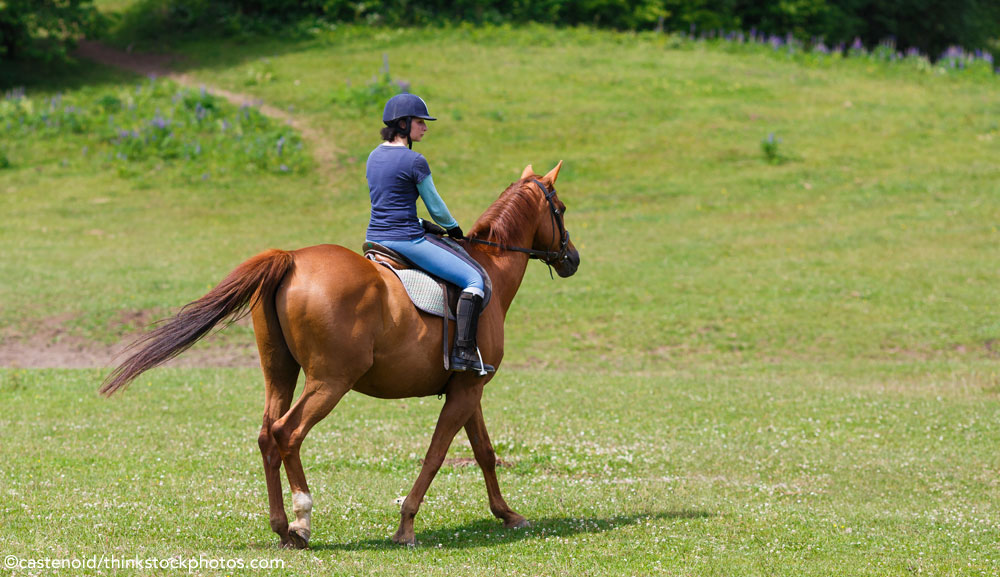
Sun Smarts
- Be smart about sun protection. Slather on the sunblock to defend against the ultraviolet rays that cause sunburn and skin cancer. You’d rather your skin not resemble old leather, right? Experts recommend an application of a full ounce (about a handful, or the equivalent of a shot glass) of SPF 15 or higher to cover your body. Apply at least 30 minutes before sun exposure so it has time to absorb into the skin. Don’t forget to reapply if you are out at the barn all day!
- Shield yourself against the sun with clothing as well. New lightweight technical fabrics with an SPF factor are available from travel, outdoor and equestrian retailers—try a long sleeve shirt to keep arms and shoulders covered.
- Put a lid on: extended visors are available to wear with a helmet, such as The EquiVisor or CashelCap. After your ride, a sporty baseball cap will hide your helmet hair and keep the sun off your face, while a wide-brimmed hat makes a sun-smart and stylish statement at home around the barn or while spectating at the showgrounds.
Bug Off
- Keep bugs off you as well as your horse! Clothing infused with Insect Shield technology is like a human flysheet.
- Mosquitoes are vectors of disease for horses and humans alike. Use repellent to keep the pests off of you: the CDC recognizes DEET and Picaridin as two safe, effective ingredients for humans. For your horse, various equine fly sprays ward off mosquitoes as well. Check the label to see which bugs are included on the kill list.
- Ticks carry the threat of disease to both you and your four-legged friends. Lyme disease is the most prevalent tick-borne disease in the US, and can affect both horses and humans. Check yourself and your pets for ticks after you’ve been out in the woods or in tall grass. Lyme disease takes 24 hours to transmit from the tick to its victim, so checking at least once a day will minimize the risk of infection.
Tick removal tips
- Using blunt tweezers, grasp the tick as close as possible to the point of attachment at the skin surface. Pull away in a slow, steady motion.
- Be careful not to squeeze the body of the tick, which might force out infectious fluids.
- Disinfect the area afterward.
Beat the Heat
- Keep your cool with clothing: breathable moisture wicking fabrics such as Coolmax and other trademarked technologies can be found in both schooling and show clothes.
- Evaporative cooling products are soaked in water to activate and draw heat away from the body with special fibers. Vests, neck coolers and under helmet or headwear items work well for equestrians. The technology is also available in products for horses and dogs.
- Schedule your ride time to avoid the hottest part of the day. Ride after the sun goes down or early in the morning before it heats up.
- Enjoy a cooling spray in the washrack along with your horse!
- When the mercury rises, keep an eye on humidity as well; high temperatures and humidity put you and your horse at risk of heat-related illness. Read more about the heat index (a calculation that includes temperature and humidity) and how it affects outdoor activities here.
- As you exert yourself (cleaning stalls, riding) your body loses water through sweat. Stay hydrated to prevent dehydration, heat exhaustion and heatstroke. Pack a water bottle or two before heading to the barn. Freeze it or add ice to keep it cool and refreshing; cool water also rehydrates the body more effectively.
- For long rides, consider a water bottle holder for your saddle. These typically go over the pommel of a western saddle or attach to dee rings on other saddle styles. Or, sip from a hydrating backpack such as the Camelbak.
- Know the symptoms of heat-relates distress: weakness, dizziness, fainting, confusion/anxiety, headache, nausea and clammy skin are some of the signs of heat exhaustion. Heat stroke is a medical emergency; additional symptoms include lack of sweating and extremely high body temp (over 104).
For your horse:
- If it’s too hot for you outside, it’s likely too hot for your horse! Save riding for a cooler day. Spend quality time with your horse in the washrack with a cooling spray, or take him hand grazing in the shade instead.
- Adjust your turnout schedule to keep horses in during the hottest or buggiest parts of the day.
- Stabled horses need adequate ventilation; maximize the airflow in your barn. Pastured horses should have access to shade.
- Provide your horse with fresh, clean water at all times. Check waterers, troughs and buckets at least once daily.
- To check your horse for dehydration, learn the pinch test— pinch an inch of skin on your horse’s neck, just above his shoulder. It should snap back into place right away. If it remains upright for more than a second or two, your horse is dehydrated.
- Many vets advise feeding a scoop of electrolytes or a few tablespoons of iodized salt to prevent dehydration.
For more on surviving summer check out these articles:







Good tips. It’s so hot here.
it gets hot here in the summer. we bought a Cool Max cooling vest. it was the best thing i ever bought!